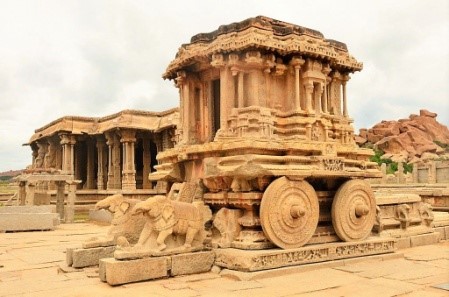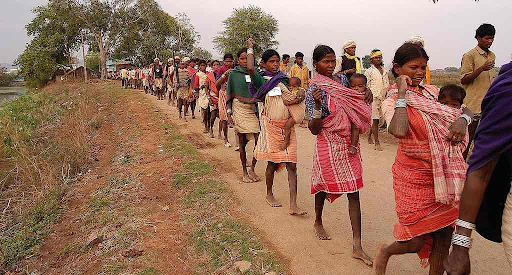Description
Context
- Recently, the Vice-president of India visited monuments at the UNESCO World Heritage Site of Hampi in
Vijayanagara district, Karnataka.

About Hampi
- Hampi is a UNESCO World Heritage Site located on the bank of Tungabhadra River in Karnataka.
- Emperor Ashoka's Rock Edicts suggest this region was part of the Maurya Empire during the 3rd century BCE.
- Hampi was under different dynasties like Chalukyas, Hoyslas and Vijaynagara empire.
- It was during the Vijaynagara empire in the 14th century under King Krishnadevaraya of Tuluva Dynasty that Hampi flourished and reached unfathomable heights.
- It became the pilgrimage centre of the Hindu religion.
- By 1500 CE, Hampi-Vijayanagara was the world's second-largest medieval-era city after Beijing.
- It was India's richest at that time, attracting traders from Persia and Portugal.
- The Vijayanagara Empire was defeated by a coalition of Muslim sultanates.
- Its capital was conquered, pillaged and destroyed by sultanate armies in 1565, after which Hampi remained in ruins.
Remarkable sites in Hampi
- Vittala Temple (God Vittala - form of lord Vishnu); Virupaksha Temple (Lord Shiva); Kadalekalu Ganesha statue (14ft); Lakshmi Narasimha statue; Lotus Mahal and Hazara Rama Temple (depicting Ramayana themes).
Vijaynagara Empire
Founder - Harihara and Bukka of the Sangama dynasty in 1336.
Alteranate Names- Karnata Empire, and the Kingdom of Bisnegar (called by the Portuguese)
Ruled till- 1646. Although its power declined after a major military defeat in the Battle of Talikota in 1565 by the combined armies of the Deccan sultanates.
Surrounds- Hampi, now a World Heritage Site in Karnataka
Capital- Vijayanagara, Penukonda, Chandragiri
.jpg)
Common languages- Kannada, Telugu, Sanskrit
Preceded by-
Hoysala Empire
Kakatiya dynasty
Kampili kingdom
Madurai Sultanate
Pandyan dynasty
MusunuriNayaks
Reddy dynasty
Succeeded by-
Kingdom of Mysore
Nayakas of Keladi
Thanjavur Nayak kingdom
Madurai Nayak dynasty
Nayakas of Chitradurga
AdilShahi dynasty
QutbShahi dynasty
Nayaks of Gingee
Sequence of Dynasties in Vijayanagara Empire
1.Sangama dynasty
2.Saluva dynasty
3.Tuluva dynasty
4.Aravidu dynasty
Administration in Vijaynagara Empire
- The Empire was a Monarchy.
- The vijaynagar Empire gradually developed a centralised administration with all its branches carefully organised.
- The king was the authority in civil, military as well as judicial affairs and also often intervened to settle social disputes.
- For purpose of administration, the empire was divided into 6 provinces.
- A province was called Prant, or Rajya.
- Each province was under a viceroy or Nayak who was either a member of the royal family or influential noble of the state.
- Every viceroy enjoyed civil, military and judiciary powers within the province.
- He was required to submit regularly account of the income and expenditure to the central government.
Council of Ministers
- Though the Brahmanas held high offices in the administration and had considerable influence, the ministers were recruited not only from the rank but also from those of the Kshatriyas and the Vaishyas.
- The office of a minister was sometimes hereditary and sometimes rested on selection.
Decentralised administration
- The rulers of Vijayanagara adopted the principle of the decentralisation of political power.
- The empire was, divided into provinces prants, districts, ‘Nadus’, ‘Melagrams’ and ‘grams’. Administration of the villages was autonomous.
Local Administration
- Each village was a self-sufficient unit. The village assembly conducted the administration of the area under its charge- executive, judicial and police, through its hereditary officers like the senateova or the village accountant, the talara or the village watchman or the commandant, the begara or the superintendent of forced labour and others.
- These village officers were paid by grants of land or a portion of agricultural produce.
- The king maintained a link with the village administration through his officer called Mahanayakacharyawho exercised a general supervision over it.
Nayankar system of administration
- Under this system, the ruler assigned a land track to officials in lieu of pay i.e. for maintaining themselves and that of their army from the land track itself.
- These officials or landlords provided military service to the ruler.
Sources of Revenue
- Land revenue was the chief source of income. Land revenue known as "sist"
- Land was divided into four categories for purposes of assessment, wet land, dry land, orchards and woods.
- So, the Vijaynagar rulers adopted the “principle of differential taxation”, that is, levied taxes according to the relative fertility of the lands.
- Usually the share was one sixth of the produce.
- Land revenue could be paid in cash or kind.
- The rates varied according to the type of the crops, soil, method of irrigation, etc.
- Apart from land revenue, other taxes were: irrigation tax, grazing tax and import- export duties on merchandise goods.
Military organization
- The army consisted of infantry, cavalry, artillery and camels.
- The rulers of Vijaynagar had a carefully organised military departments called ‘Kandachara’, under the control of the Dandanayaka or Dannayaka (commander – in-chief) who was assisted by a staff of minor officials.
- The State maintained a large and efficient army, the numerical strength of which was not, however, uniform all through.
- The rulers of the Vijayanagara empire neglected naval power.
- The rulers recruited Turkish archers in the army.
- The military organisation was rather weak and its primary weakness was artillery.
- Chariots had gone out of use. The efficiency of the huge army was not proportionate to the number of force.
Orders of the Rulers
- No written orders were issued by the rulers.
- The royal words were carefully noted down by secretaries, whose record was the sole evidence of the commands issued.
Judiciary
- The king as the supreme judge, but there were regular courts and special judicial officers for the administration of justice.
- Sometimes, disputes were settled by the State officials with the co-operation of the local bodies.
- The only law of the land was not the law of the Brahmanas, but was based on traditional regulations and customs strengthened by the constitutional usage of the country, and its observance was strictly enforced.
- Severe punishment was inflicted on guilty persons.
- These penalties were chiefly of four kinds- fines, confiscation of property, ordeals and death.
- Death or mutilation was the punishment of crimes like thefts, adultery and treason.
Position of Women
- Women occupied a high position and took an active part in political, social and literary life of the empire.
- They were educated and trained in wrestling, in the use of various weapons of offence and defense, in music and fine arts.
- Some women also received education of high order.
- Nuniz writes that the kings had women astrologers, clerks, accountants, guards and wrestlers
Social Life
- The practice of untouchability existed.
- Child marriage, polygamy and sati were prevalent.
- Caste was determined either by individual’s occupation or the community they belonged to.
Economy
- The economy was dependent on Agriculture.
- The empire’s capital city was the main business hub.
- The capital city was noted for its markets dealing in spices, textiles and precious stones.
- Land ownership was important.
- Textiles, mining, metallurgy perfumery, and other several industries existed.
- They had commercial relations with, the islands in the Indian Ocean, Abyssinia, Arabia, Burma, China, Persia, Portugal, South Africa, and The Malay Archipelago.
Contribution to Architecture and Literature
- The Hazara Rama temple and Vittalaswamy temple was built during this period.
- Vijayanagara architecture is the combination of Chalukya, Hoysala, Pandya and Chola styles.
- The bronze image of Krishnadevaraya is a masterpiece.
- Sanskrit, Tamil, Telugu and Kannada literature were developed.
- Sayana wrote commentaries on Vedas.
- Krishnadevaraya wrote Amuktamalyada in Telugu and UshaParinayam and JambavathiKalyanamin Sanskrit.
- Field surveys indicate that the entire area was dotted with numerous shrines and small temples which proved that variety of cultures existed and were supported by different communities.
About Krishnadevaraya
- Krishna Devaraya was the emperor of the Vijayanagara Empire during 1509–1529.
- He was the third ruler of the Tuluva Dynasty and is considered to be its greatest ruler.
- He possessed the largest empire in India after the decline of the Delhi Sultanate.
- Krishnadevaraya earned the titles Kannada Rajya Rama Ramana, Andhra Bhoja and MooruRayaraGanda (lit, "King of Three Kings").
- He became the dominant ruler of the peninsula of India by defeating the Sultans of Bijapur, Golconda, the Bahmani Sultanate and the Gajapatis of Odisha, and was one of the most powerful Hindu rulers in India.
- The Vijayanagar kingdom reached the pinnacle of its glory during his reign.
- He was successful in all the wars he waged. He defeated the king of Odisha and annexed Vijaywada and Rajmahendri.
- Krishnadeva Raya encouraged trade with the western countries.
- He had a cordial relationship with the Portuguese who had at that time established trade centres on the west coast of India.
- The decline of the Vijayanagar kingdom began with the death of Krishnadeva Raya in 1529.
- The kingdom came to an end in 1565, when Ramrai was defeated at Talikota by the joint efforts of Adilshahi, Nizamshahi, Qutubshahi and Baridshahi. After this, the kingdom broke into small states.
- Portuguese travellers Domingo Paes and FernaoNuniz also visited the Vijayanagara Empire during his reign.
- The South Indian poet MukuTimmana praised him as the destroyer of the Turkics.
His Art and Literature
- The rule of Krishna Deva Raya was an age of prolific literature in many languages, although it is also known as a golden age of Telugu literature.
- Thus, he was not only a great warrior, but was also a playwright and a great patron of learning.
- Telegu literature flourished under him.
- Painting, sculpture, dance and music were greatly encouraged by him and his successors.
- Emperor Krishna Deva Raya was fluent in many languages.
- Krishna dev Raya took the title of Abhinava-Bhoja and Sakala-Kala-Bhoja("Bhoja of all the arts") in the honour of Parmara emperor Bhoja who was polymath, a master of 64 arts and a military genius.
- The poet MukkuTimma was his great admirer.
- Ashtadiggajas: A group of eight scholars adorned his court and they were:
- Allasani Peddanna – the author of Manucharitram, he was also known as Andhra Kavitapitamaha
- Nandi Thimmana – the author of Parijathapaharanam
- Dhurjati
- AyyalarajuRamabhadraKavi
- PingaliSurana
- RamarajaBhushana
- Tenali Ramakrishna
https://www.thehindu.com/news/national/karnataka/vice-president-sees-musical-pillars-of-hampi/article36029217.ece





.jpg)









